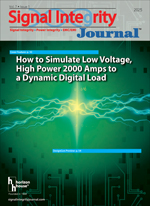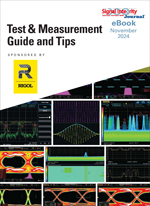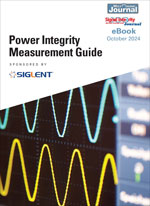eBook Library
Please note:
By downloading an eBook, the details of your profile will be shared with the sponsoring company and you may be contacted by them directly.
The material presented in these PDF documents is owned by the sponsoring company and Signal Integrity Journal™. It is presented here to be downloaded by an individual for educational purposes. It may not be downloaded from this site and reposted elsewhere.
eBooks by Content Type:
New eBooks:
SIJ January 2025 Issue: How to Simulate Low Voltage, High Power 2000 Amps to a Dynamic Digital Load
Subscribe to download this issue of Signal Integrity Journal featuring articles from industry experts including:
- “The Need for Speed and the Cost in Power,” Eric Bogatin, Signal Integrity Journal
- “How to Simulate Low Voltage, High Power 2000 Amps to a Dynamic Digital Load,” Heidi Barnes, Keysight Technologies; Steve Sandler, Picotest; and Benjamin Dannan, Signal Edge Solutions
- “Reflections on the Origins of COM,” Rich Mellitz, Samtec
- “Ultrafast Impedance Measurement of Active Ultra-High Current PDNs,” Steve Sandler, Picotest
- “How Interconnects Work: Crosstalk Quantification,” Yuriy Shlepnev, Simberian Inc
- “Analysis of Skew,” Gustavo Blando and Prashant Pappu, Amazon Web Services
- “A Subtle Problem to Avoid in Your Next Design,” Eric Bogatin, Signal Integrity Journal, and Dheeraj Gooty, University of Colorado Boulder
- “Created by Engineers, for Engineers: DesignCon Celebrates 30 Years,” Suzanne Deffree, DesignCon
_______________________________________________________________________________________________
Latest Trends in Power Integrity
As the demand for faster, smaller, and more efficient electronic devices grows, ensuring that power delivery net¬works (PDNs) can meet the stringent requirements of advanced technologies is paramount. In addition, new chip designs are requiring higher and higher currents in the thousands of amps range. This eBook, "Latest Trends in Power Integrity," explores advancements and methods for managing and optimizing power integrity in modern systems. From ultrafast impedance measurements to the intricate analysis of decoupling capacitors, this guide will provide insights into the emerging challenges and solutions in the world of power integrity.
_______________________________________________________________________________________________
Test & Measurement Guide and Tips
This eBook covers a range of advanced concepts, from understanding the bandwidth of signals to conducting in-depth real-time analysis, and addresses the challenges faced by today’s engineers in keeping up with rigorous standards and ever-evolving requirements. The first article dives into the fundamentals of bandwidth of signals, exploring how bandwidth impacts system performance and the importance of selecting the right tools for capturing signal data accurately. Moving into more sophisticated territory, we address embedded systems debug with jitter and real-time dye analysis. Embedded systems are increasingly complex, requiring robust debugging tools to maintain reliable performance under tight timing constraints. This section covers jitter—a key parameter in time-domain analysis that can impair data accuracy—and how it can be mitigated using advanced tools. The guide also compares spectrum analyzers: GPSA vs. RTSA. General purpose spectrum analyzers (GPSA) and real-time spectrum analyzers (RTSA) each have unique advantages and limitations. Finally, we look at power integrity testing, an area of growing significance as electronic systems become more power-dense and sensitive to fluctuations. Power integrity impacts everything from processor stability to overall system longevity, and effective testing requires specialized tools and methodologies.
_______________________________________________________________________________________________
Power Integrity Measurement Guide
In today’s high-performance electronic systems, power integrity (PI) has become a critical design and operational factor. With the increasing complexity of circuits, higher frequencies, and shrinking geometries, ensuring stable and clean power delivery across all components is essential. Unstable power supplies can result in signal integrity issues, degraded performance, or even system failure.
This eBook aims to serve as a resource for engineers, designers, and technical professionals looking to understand and improve power integrity in their systems by covering some new topics in this area. The articles cover interconnect requirements for power integrity testing, measuring high output voltage regulator noise, advanced power integrity measurement solutions, why measuring only board-level power rail noise may be misleading, and solving PI problems in FPGA systems.
_______________________________________________________________________________________________
High Speed Interconnect Solutions Guide
The importance of high-speed interconnect solutions cannot be overstated. Whether powering the backbone of global telecommunications networks, accelerating the data processing capabilities of cloud computing infrastructure, or enhancing the performance of consumer electronics, these solutions are the foundation upon which modern connectivity is built. This eBook guide covers interconnect design challenges for 224G systems and PCIe 6.0 plus the various testing techniques needed to evaluate and test these systems. The introductory article also covers some history of how we have progressed from 1 Gbps NRZ to 224 Gbps PAM4 so is a nice perspective on the evolution of interconnect technology.
_______________________________________________________________________________________________
Identifying and Solving EMC/EMI Problems
The need to address EMC/EMI problems has never been more pressing. As electronic devices become smaller, faster, and more powerful, the potential for interference grows exponentially. It's no longer sufficient to simply design and build electronic systems without considering their EMC/EMI characteristics. Engineers, designers, and technicians must proactively identify and mitigate these issues to ensure that their products meet regulatory standards, perform reliably, and avoid costly setbacks. This eBook provides an understanding of the underlying principles, practical methodologies, and advanced techniques for dealing with EMC/EMI challenges. It is designed for both newcomers seeking a foundational knowledge of the subject and experienced professionals looking to deepen their expertise.
_______________________________________________________________________________________________
Getting the Jitter Out - High Speed Communications Timing Technology
This eBook focuses on jitter, simply defined as any effect that causes signal threshold crossing times to deviate from their expected positions. The first article addresses the inter-relationships between jitter and other noise-generating mechanisms.
_______________________________________________________________________________________________
End-to-End High-Speed Digital Design
High-speed digital links at 224 Gbps per lane, device miniaturization, and ultra-low power budgets result in sophisticated systems that are more complex to optimize signal integrity performance and reliability. Engineers require close collaboration and seamless flows from concept to simulation, emulation, and testing to keep up with technology's pace and meet shrinking time-to-market expectations.
This eBook covers how to connect design workflows to make end-to-end high-speed digital design a reality. It will discuss the challenges and trade-offs associated with optimizing design performance for technologies such as PCIe 6.0, USB4 Version 2.0, and USB-C, DDR5, and LPDDR.








